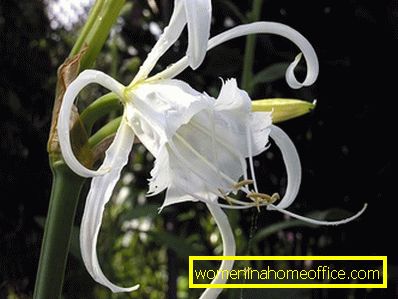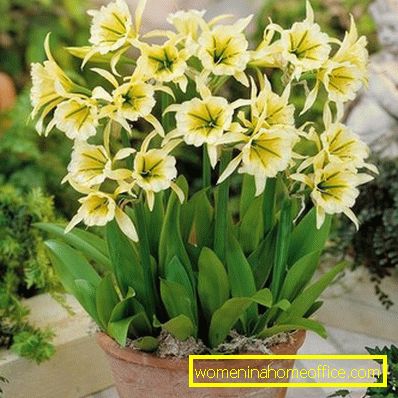Southern handsome - gimenokallis
How many different colors we grow on our windowsills. What for?
Everything is very simple, because vegetation decorates our house, refreshing and transforming the interior of the rooms.
It is important to choose the right flowers.
Selection is made, firstly, based on personal preferences. Secondly, according to which of the cultures they get along with. And then, of course, attention is paid to how beautiful these or other green representatives will look like and combining with each other, and starting from the general interior situation of your apartment or house.
But, first of all, in order to find something worthwhile for yourself, you need to know the names and appearance of the plants.
Of course, we are already growing some crops at home, as well as seeing vegetation with neighbors, friends or relatives. Such observations as well as possible stimulate the desire to plant something new. However, I will try to interest you. How to ask? I will tell you about one of the representatives of cultivated plants, which can later become your favorite pet and decorate your home as well as possible.
I want to introduce you to a plant with a very unusual name for our country - hymenocallis.

This plant is not familiar to us, since the native habitats of hymenocallis are found in the West Indies, South American countries, and the Antilles.
Culture is widely distributed as a decorative appearance for a closed ground.
Gimenokallis belongs to the Amaryllis family. This is a very beautiful bulbous plant.
But what does hymenocallis look like?
Appearance of hymenocallis
The very first thing to talk about is the onion. The basis of everything, as they say.
So, the bulb of hymenocallis is quite large and can reach seven centimeters in length, and in width to ten centimeters. It is covered with light brown sandpaper.
From the bulb, we can observe the passage of small leaves. They are belt-shaped and sharp at the tips. Such foliage, forming near the bulb itself, is very soft and tender to the touch. In length, the leaves of hymenocallis can reach up to forty - sixty centimeters.
In the autumn - winter period (meaning the time interval is approximately from the beginning of October to December), the bulb throws out rather high peduncles. It is on them that the inflorescences are formed, representing peculiar umbrellas. Biologists call these inflorescences an umbrella.
Each inflorescence subsequently bears on itself up to seven - fifteen buds, which over time will open and turn into wonderful, fragrant flowers of pretty large size.
Hymenocallis flowers are very interestingly shaped with the help of petals that twist in an unusual way to the base of the flower. The corolla of each flower bears on itself a small crown of stamens, which grow together in its lower part.
Flowers of hymenocallis are distinguished by a very pleasant delicate white shade.
And what flavor they exude !!! It looks like a faint, subtle vanilla smell. Imagine how nice it is to have such flowers in your home.
Gimenokallis, like many other plants, is represented by a very wide variety of species groups.
However, the most common of them are: hymenocallis is beautiful and hymenocallis is Caribbean.

The first type is most often found on the territory of our state as a cultivated plant that decorates houses and apartments. Its flowers are collected in neat umbrella inflorescences and are distinguished by a delicate yellow or white shade.
The second species, namely Hymenocallis of the Caribbean, has only snow-white small flowers with a pleasant aroma.
Use of hymenocallis
Hymenocallis is used as one of those plant crops that adorns the apartments and houses. As a rule, hymenocallis is not used for refining garden and dacha plots.
If you decide to improve your window sills with hymenocalyssus, then place it on the east or west side.
Planting hymenocallis
The plant is very, very thermophilic. Accordingly, take a warm and dry place under it and scattered, and not direct sunlight.
It will be optimal to create a temperature regime for landings in the range of plus fifteen to eighteen degrees.
Planting is done using bulbs. They are called daughter bulbs and are separated from the parent base during transplantation.
Provide for planting spacious drawers or baskets. Dissolving the bulbs with earth should not be completely, but only one fourth of the surface.
The soil for planting can be purchased ready in specialized flower shops. However, if you work hard, make an effort, say efforts, then you can prepare the soil mixture yourself. For this it will be enough to mix ordinary garden soil with humus.
Before planting, the bulb must be thoroughly cleaned and placed in the soil layer.
After planting, do not forget to water your plant.
If you decide to place several bulbs in one container, then, accordingly, you will need to maintain a distance between plantings of at least fifteen, and preferably twenty centimeters.

Hymenocallis care
Humidity is not essential for the cultivation of hymenocalyse. Accordingly, he will not require you to endless procedures for spraying plantings.
However, like any other plant, hymenocallis requires moisture in the form of irrigation.
Water for irrigation, use well-settled and slightly warm, so as not to harm the root system.
It is best to feed hymenocallis during the flowering period. It will be enough to feed once every one to two weeks. In winter, when there is a period of rest for the plant, it is not necessary to feed it, but you can do it no more than once per month.
Transplant is carried out as needed. If we are talking about young plants that are characterized by rapid growth and development, then they are better to replant once a year or two years. Adult specimens will require new habitat after four years.
Transplantation can not be carried out during the flowering period, but only at rest.